
The Asclepiadoideae are a subfamily of plants in the family Apocynaceae. Formerly, it was treated as a separate family under the name Asclepiadaceae, e.g. by APG II, and known as the milkweed family.

Hoodia is a genus of flowering plants in the family Apocynaceae, under the subfamily Asclepiadoideae, native to Southern Africa.

Hoodia juttae is a species of plant in the family Apocynaceae. It is endemic to Namibia. Its natural habitats are rocky areas and cold desert. H. juttae is found around the Little and Great Karas mountains. It is threatened by collection. The plant was discovered by Jutta Dinter, the wife of botanist, Kurt Dinter in 1913. The scientific name refers to Jutta.

Hoodia ruschii is a species of stem succulent plant in the family Apocynaceae. It is endemic to Namibia. Its natural habitats are rocky areas and cold desert.
Hoodia triebneri is a species of plant in the family Apocynaceae. It is endemic to Namibia. Its natural habitat is rocky areas, especially underneath Acacia trees and below ridges.

Hylotelephium spectabile is a species of flowering plant in the stonecrop family Crassulaceae, native to China and Korea. Its common names include showy stonecrop, iceplant, and butterfly stonecrop.

Hydnora africana is an achlorophyllous plant in the subfamily Hydnoroideae, native to southern Africa that is parasitic on the roots of members of the family Euphorbiaceae. It is also called jakkalskos or jackal food. The specific epithet africana means to be from Africa. Molecular data has suggested that Hydnoroideae is a "basal angiosperm" solidifying its place among the more primitive flowering plants. Hydnoraceae are the only angiosperms known to have no leaves or scales and are considered obligate parasites, completely dependent on their hosts to survive. The plant grows underground, except for a fleshy flower that emerges above ground and emits an odour of faeces to attract its natural pollinators, dung beetles and carrion beetles. The vegetative body of the plants has been reduced to consisting only of roots and flowers. The flowers act as temporary traps, retaining the beetles that enter long enough for them to pick up pollen.

In botany, succulent plants, also known as succulents, are plants with parts that are thickened, fleshy, and engorged, usually to retain water in arid climates or soil conditions. The word succulent comes from the Latin word sucus, meaning "juice" or "sap".

Jatropha cathartica is a species of flowering plant in the spurge family, Euphorbiaceae, that is native to Texas in the United States and Coahuila, Nuevo León and Tamaulipas in northeastern Mexico. Common names include jicamilla (Spanish) and Berlandier's nettlespurge.

Lewisiopsis tweedyi is a flowering plant and sole species in genus Lewisiopsis. The species, formerly known as Cistanthe tweedyi and Lewisia tweedyi, is now classified in the family Montiaceae. The plant is known by the common names Tweedy's pussypaws, Tweedy's lewisia, or Tweedy's bitterroot. It is endemic to western North America in north-central Washington and adjacent British Columbia. It commonly grows on well-drained slopes often on rocky slopes or in rock crevices from low elevation ponderosa pine sites up to the drier part of the Grand Fir zone of the North Cascades. The flowers usually have a coral, apricot, or pink color.
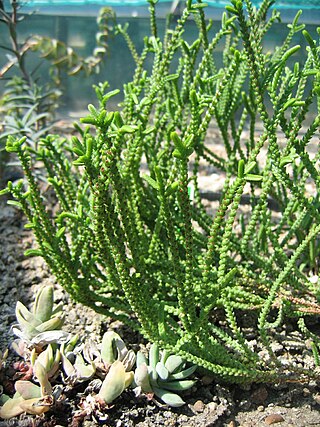
Crassula muscosa, synonyms Crassula lycopodioides and Crassula pseudolycopodioides, is a succulent plant native to South Africa and Namibia, belonging to the family of Crassulaceae and to the genus Crassula. It is a houseplant grown worldwide and commonly known as rattail crassula, watch chain, lizard's tail, zipper plant and princess pines.
Hoodia flava is a succulent native to the Cape Province in South Africa and to Namibia. It has a unique pattern of distribution, growing inside bushes or on gravelly slopes and hills. It is commonly known as ghaap or yellow-flowered ghaap in the Afrikaans language.

Crassula ovata, commonly known as jade plant, lucky plant, money plant or money tree, is a succulent plant with small pink or white flowers that is native to the KwaZulu-Natal and Eastern Cape provinces of South Africa, and Mozambique; it is common as a houseplant worldwide. Much of its popularity stems from the low levels of care needed; the jade plant requires little water and can survive in most indoor conditions. It is sometimes referred to as the money tree; however, Pachira aquatica also has this nickname.
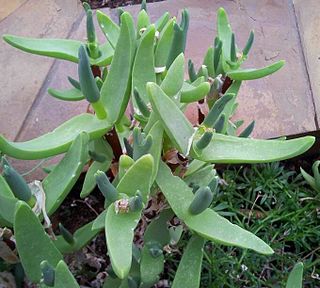
Mitrophyllum is a genus of succulent plants of the family Aizoaceae, indigenous to the arid region around the Richtersveld, on the border of South Africa and Namibia.

Piaranthus is a succulent plant genus in the subfamily Asclepiadoideae, in the family Apocynaceae.
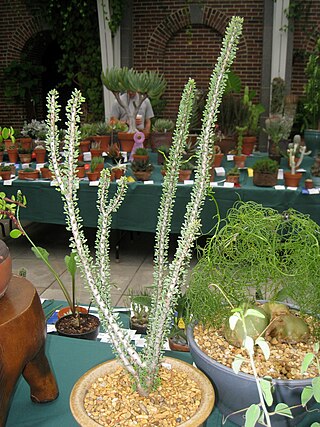
Portulacaria namaquensis, synonym Ceraria namaquensis, with the common names Namaqua porkbush and Namaqua portulacaria, is a species of succulent shrub, native to the border between the Cape Provinces of South Africa and Namibia.

Ipomoea oenotherae is a species of plant of the morning glory genus, Ipomoea, in the family Convolvulaceae. It derives its name from the resemblance it bears to plants in the genus Oenothera. Ipomoea oenotherae is a succulent and a cryptophyte.
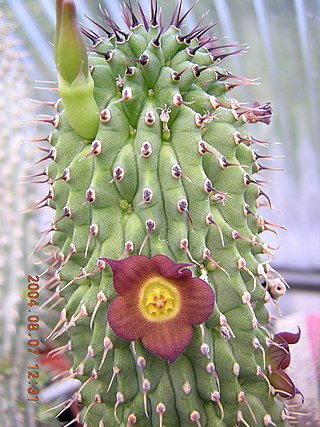
Hoodia officinalis is a succulent plant native to Namibia and the Cape Province of South Africa. H. officinalis has two officially recognized subspecies, H. officinalis subsp. officinalis and subsp. delaetiana, which are identified mainly by their distribution. Subsp. delaetiana grows only in the Klinghardt Mountains and are larger than subsp. officinalis.
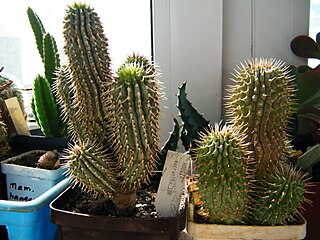
Hoodia macrantha is a succulent plant native to Namibia and the Cape Province of South Africa. It is regarded by some sources as a synonym of the accepted name for the plant, Hoodia currorii subsp. currorii.

Hoodia currorii is a succulent plant native to Namibia and the Cape Province of South Africa. It grows in desert areas and is common along the road from Karibib to Swakopmund in Namibia. It is also known as ghaap in the vernacular.


















